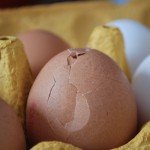By Helen King (Regular Contributor)
One of the best-known stories from the ancient Greek medical texts tells of a slave entertainer who became pregnant but didn’t know what to do about it. In one of the versions that survived, from the Hippocratic treatise On Generation/Nature of the Child, she realized she was pregnant and told her owner, who in turn called in the writer of the story, a physician.
How did the girl know she was pregnant? Other Greek texts say that women know because they feel a very special sensation, that of the mouth of the womb shutting. Here, though, we are told that the girl had heard other women say that you know you are pregnant because the man’s seed doesn’t run out after sex.
There’s a fascinating reference in this same treatise to the belief that a woman can choose to expel the seed emitted both by her and by her partner ‘when this is what the woman intends’. What is that about? And if it’s so easy, why didn’t the slave just expel the seed? Perhaps she tried, but failed. Or maybe she’d not heard about this technique.
The Lacedaimonian Leap
So what happened? What did the physician advise? Something that later historians have labeled ‘the Lacedaimonian leap’, a pleasingly alliterative name referencing Lacedaimonia, the area around ancient Sparta, and recalling ancient accounts of the women of Sparta as both athletic and independent. What this writer in fact suggests is that the girl should jump up and down with her heels touching her buttocks on each leap; after seven of these leaps (perhaps a significant total, in terms of beliefs about the power of certain numbers), the seed comes out with a noise, and has the appearance ‘as if someone had removed the external shell of a raw egg, and the fluid part inside was visible through the internal membrane’ (tr. Potter). In the middle there is something that appears to the writer to be an umbilical cord ‘and through this the movement of breath in and out first took place’.
Seeds and Eggs
The writer confidently describes this as a seed ‘on the sixth day’. Clearly, it isn’t. But the reference to an egg is really tantalizing. In ancient Greece, some writers thought that both men and women contributed ‘seed’ to make a baby; others thought that the man’s seed mixed with the raw material of the woman’s blood; and others seem to have thought that the man plants his seed in a woman’s body, without any female contribution other than the ‘soil’. Nobody talks about women having ‘eggs’. And of course this writer doesn’t, either; instead he draws an analogy with the gestation of a chick. Elsewhere in this treatise, he recommends looking at hen’s eggs, opening one per day to observe how the chick develops, because humans grow in just the same way, starting with a speck of blood which is the umbilicus, and then, through taking in ‘breath’, this speck inflating until it forms a recognizable living being.
And hens and women connect on a number of levels. The ancient Greek medical texts also describe how the process of labor is about the baby pecking its way out of the womb like a chick out of an egg. Here, the womb is passive, and there’s nothing for the woman giving birth to do except wait for the baby to work its way out. So human conception, gestation and birth all resemble those processes in hens. However, I don’t think there are any references to hens doing the ‘Lacedaimonian leap’, either with, or without, the seal of approval from a physician!
Reference:
Potter, Paul (transl.) Nature of the Child, Hippocrates, vol. X, Cambridge, MA: Harvard University Press.

